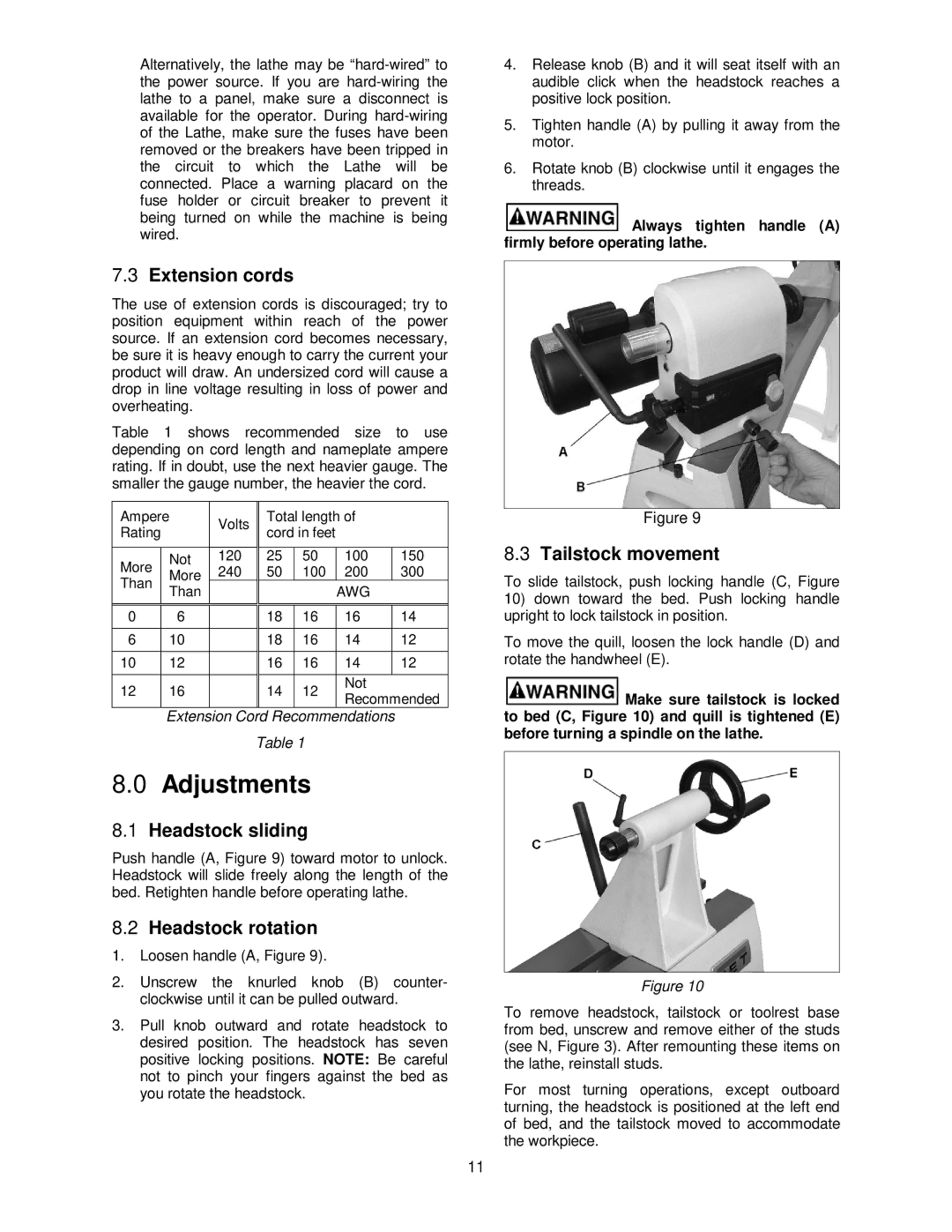
Alternatively, the lathe may be
7.3Extension cords
The use of extension cords is discouraged; try to position equipment within reach of the power source. If an extension cord becomes necessary, be sure it is heavy enough to carry the current your product will draw. An undersized cord will cause a drop in line voltage resulting in loss of power and overheating.
Table 1 shows recommended size to use depending on cord length and nameplate ampere rating. If in doubt, use the next heavier gauge. The smaller the gauge number, the heavier the cord.
Ampere | Volts | Total length of |
| |||
Rating |
| cord in feet |
|
| ||
|
|
|
| |||
|
|
|
|
|
|
|
More | Not | 120 | 25 | 50 | 100 | 150 |
More | 240 | 50 | 100 | 200 | 300 | |
Than | Than |
|
|
| AWG |
|
|
|
|
|
| ||
|
|
|
|
|
|
|
0 | 6 |
| 18 | 16 | 16 | 14 |
|
|
|
|
|
|
|
6 | 10 |
| 18 | 16 | 14 | 12 |
|
|
|
|
|
|
|
10 | 12 |
| 16 | 16 | 14 | 12 |
|
|
|
|
|
|
|
12 | 16 |
| 14 | 12 | Not |
|
| Recommended | |||||
|
|
|
|
| ||
Extension Cord Recommendations
Table 1
8.0Adjustments
8.1Headstock sliding
Push handle (A, Figure 9) toward motor to unlock. Headstock will slide freely along the length of the bed. Retighten handle before operating lathe.
8.2Headstock rotation
1.Loosen handle (A, Figure 9).
2.Unscrew the knurled knob (B) counter- clockwise until it can be pulled outward.
3.Pull knob outward and rotate headstock to desired position. The headstock has seven positive locking positions. NOTE: Be careful not to pinch your fingers against the bed as you rotate the headstock.
4.Release knob (B) and it will seat itself with an audible click when the headstock reaches a positive lock position.
5.Tighten handle (A) by pulling it away from the motor.
6.Rotate knob (B) clockwise until it engages the threads.
![]() Always tighten handle (A) firmly before operating lathe.
Always tighten handle (A) firmly before operating lathe.
Figure 9
8.3Tailstock movement
To slide tailstock, push locking handle (C, Figure
10)down toward the bed. Push locking handle upright to lock tailstock in position.
To move the quill, loosen the lock handle (D) and rotate the handwheel (E).
![]() Make sure tailstock is locked to bed (C, Figure 10) and quill is tightened (E) before turning a spindle on the lathe.
Make sure tailstock is locked to bed (C, Figure 10) and quill is tightened (E) before turning a spindle on the lathe.
Figure 10
To remove headstock, tailstock or toolrest base from bed, unscrew and remove either of the studs (see N, Figure 3). After remounting these items on the lathe, reinstall studs.
For most turning operations, except outboard turning, the headstock is positioned at the left end of bed, and the tailstock moved to accommodate the workpiece.
11
